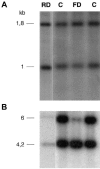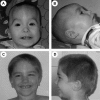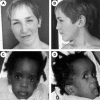Paradoxical NSD1 mutations in Beckwith-Wiedemann syndrome and 11p15 anomalies in Sotos syndrome
- PMID: 14997421
- PMCID: PMC1181947
- DOI: 10.1086/383093
Paradoxical NSD1 mutations in Beckwith-Wiedemann syndrome and 11p15 anomalies in Sotos syndrome
Abstract
Sotos syndrome is an overgrowth syndrome characterized by pre- and postnatal overgrowth, macrocephaly, advanced bone age, variable degrees of mental retardation, and typical facial features. Defects of the NSD1 gene account for >or=60% of cases of Sotos syndrome, whereas the disease-causing mechanism of other cases remains unknown. Beckwith-Wiedemann syndrome (BWS) is a distinct overgrowth condition characterized by macroglossia, abdominal-wall defects, visceromegaly, embryonic tumors, hemihyperplasia, ear anomalies, renal anomalies, and neonatal hypoglycemia. Deregulation of imprinted growth-regulatory genes within the 11p15 region is the major cause of BWS, whereas the molecular defect underlying a significant proportion of sporadic BWS cases remains unknown. Owing to clinical overlaps between the two syndromes, we investigated whether unexplained cases of Sotos syndrome could be related to 11p15 anomalies and, conversely, whether unexplained BWS cases could be related to NSD1 deletions or mutations. Two 11p15 anomalies were identified in a series of 20 patients with Sotos syndrome, and two NSD1 mutations were identified in a series of 52 patients with BWS. These results suggest that the two disorders may have more similarities than previously thought and that NSD1 could be involved in imprinting of the chromosome 11p15 region.
Figures



Similar articles
-
Tumor development in the Beckwith-Wiedemann syndrome is associated with a variety of constitutional molecular 11p15 alterations including imprinting defects of KCNQ1OT1.Hum Mol Genet. 2001 Dec 15;10(26):2989-3000. doi: 10.1093/hmg/10.26.2989. Hum Mol Genet. 2001. PMID: 11751681
-
Analysis of the methylation status of the KCNQ1OT and H19 genes in leukocyte DNA for the diagnosis and prognosis of Beckwith-Wiedemann syndrome.Eur J Hum Genet. 2001 Jun;9(6):409-18. doi: 10.1038/sj.ejhg.5200649. Eur J Hum Genet. 2001. PMID: 11436121
-
Relaxation of insulin-like growth factor 2 imprinting and discordant methylation at KvDMR1 in two first cousins affected by Beckwith-Wiedemann and Klippel-Trenaunay-Weber syndromes.Am J Hum Genet. 2000 Mar;66(3):841-7. doi: 10.1086/302811. Am J Hum Genet. 2000. PMID: 10712200 Free PMC article.
-
Beckwith-Wiedemann syndrome.Am J Med Genet C Semin Med Genet. 2010 Aug 15;154C(3):343-54. doi: 10.1002/ajmg.c.30267. Am J Med Genet C Semin Med Genet. 2010. PMID: 20803657 Review.
-
[Beckwith-Wiedemann syndrome].Nihon Rinsho. 2000 Jul;58(7):1511-4. Nihon Rinsho. 2000. PMID: 10921333 Review. Japanese.
Cited by
-
Analysis of the NSD1 promoter region in patients with a Sotos syndrome phenotype.J Hum Genet. 2006;51(1):15-20. doi: 10.1007/s10038-005-0314-0. Epub 2005 Oct 27. J Hum Genet. 2006. PMID: 16252063
-
In Pursuit of New Imprinting Syndromes by Epimutation Screening in Idiopathic Neurodevelopmental Disorder Patients.Biomed Res Int. 2015;2015:341986. doi: 10.1155/2015/341986. Epub 2015 May 27. Biomed Res Int. 2015. PMID: 26106604 Free PMC article.
-
Methylation analysis of histone H4K12ac-associated promoters in sperm of healthy donors and subfertile patients.Clin Epigenetics. 2015 Mar 19;7(1):31. doi: 10.1186/s13148-015-0058-4. eCollection 2015. Clin Epigenetics. 2015. PMID: 25806092 Free PMC article.
-
NSD1 inactivation defines an immune cold, DNA hypomethylated subtype in squamous cell carcinoma.Sci Rep. 2017 Dec 6;7(1):17064. doi: 10.1038/s41598-017-17298-x. Sci Rep. 2017. PMID: 29213088 Free PMC article.
-
H3K36 methyltransferase NSD1 is essential for normal B1 and B2 cell development and germinal center formation.Front Immunol. 2022 Nov 30;13:959021. doi: 10.3389/fimmu.2022.959021. eCollection 2022. Front Immunol. 2022. PMID: 36532012 Free PMC article.
References
Electronic-Database Information
-
- Online Mendelian Inheritance in Man (OMIM), http://www.ncbi.nlm.nih.gov/Omim/ (for Sotos syndrome, BWS, NSD1, KCNQ1OT, and H19)
-
- University of California–Santa Cruz (UCSC) Genome Bioinformatics, http://genome.cse.ucsc.edu/ (for chromosome 11 physical map [updated July 2003])
References
-
- Elliott M, Bayly R, Cole T (1994) Clinical features and natural history of Beckwith-Wiedemann syndrome: presentation of 74 new cases. Clin Genet 46:168–174 - PubMed
Publication types
MeSH terms
Substances
Associated data
- Actions
- Actions
- Actions
- Actions
LinkOut - more resources
Full Text Sources
Other Literature Sources
Molecular Biology Databases

